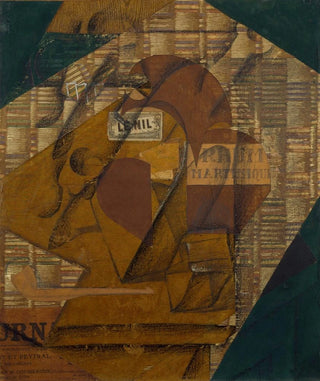Art print | Rum bottle and newspaper - Juan Gris


View from behind

Frame (optional)
The artwork "Bouteille de rhum et journal" by Juan Gris immerses us in the fascinating world of Cubism, an artistic movement that redefined visual representation standards in the early 20th century. Observing this composition, the viewer is immediately captivated by how the artist plays with shapes and volumes, creating a visual harmony that transcends mere still life. The bottle, the newspaper, and the surrounding objects are not just everyday elements but become symbols of a particular era, culture, and artistic sensibility. Gris, with his unique style, manages to transform ordinary objects into a rich and evocative aesthetic experience.
Style and uniqueness of the artwork
The uniqueness of "Bouteille de rhum et journal" lies in how Juan Gris deconstructs forms and reassembles them into a new reality. The carefully chosen colors oscillate between warm and cool tones, creating a contrast that draws the eye and stimulates the imagination. The composition, though complex, is remarkably clear, with each element having its place and role. The bottle, with its angular contours, almost seems to vibrate on the canvas, while the newspaper, with its unfolded pages, evokes a story waiting to be discovered. Gris also uses shadow and light to give depth to his objects, making them almost tangible. This innovative approach makes this artwork a perfect example of the interaction between abstraction and figuration, a key characteristic of Cubism.
The artist and his influence
Juan Gris, born in Spain, quickly made his mark on the Parisian art scene, standing out for his intellectual approach and technical mastery. Influenced by masters like Pablo Picasso and Georges Braque, he developed a style that is uniquely his own, combining rigor and creativity. His work, although deeply rooted in Cubism, demonstrates a unique sensitivity, blending references to artistic tradition while exploring new avenues. Gris not only contributed to the evolution of Cubism but also paved the way for future artistic movements by incorporating elements of popular culture and everyday objects into his art.

Matte finish

View from behind

Frame (optional)
The artwork "Bouteille de rhum et journal" by Juan Gris immerses us in the fascinating world of Cubism, an artistic movement that redefined visual representation standards in the early 20th century. Observing this composition, the viewer is immediately captivated by how the artist plays with shapes and volumes, creating a visual harmony that transcends mere still life. The bottle, the newspaper, and the surrounding objects are not just everyday elements but become symbols of a particular era, culture, and artistic sensibility. Gris, with his unique style, manages to transform ordinary objects into a rich and evocative aesthetic experience.
Style and uniqueness of the artwork
The uniqueness of "Bouteille de rhum et journal" lies in how Juan Gris deconstructs forms and reassembles them into a new reality. The carefully chosen colors oscillate between warm and cool tones, creating a contrast that draws the eye and stimulates the imagination. The composition, though complex, is remarkably clear, with each element having its place and role. The bottle, with its angular contours, almost seems to vibrate on the canvas, while the newspaper, with its unfolded pages, evokes a story waiting to be discovered. Gris also uses shadow and light to give depth to his objects, making them almost tangible. This innovative approach makes this artwork a perfect example of the interaction between abstraction and figuration, a key characteristic of Cubism.
The artist and his influence
Juan Gris, born in Spain, quickly made his mark on the Parisian art scene, standing out for his intellectual approach and technical mastery. Influenced by masters like Pablo Picasso and Georges Braque, he developed a style that is uniquely his own, combining rigor and creativity. His work, although deeply rooted in Cubism, demonstrates a unique sensitivity, blending references to artistic tradition while exploring new avenues. Gris not only contributed to the evolution of Cubism but also paved the way for future artistic movements by incorporating elements of popular culture and everyday objects into his art.






